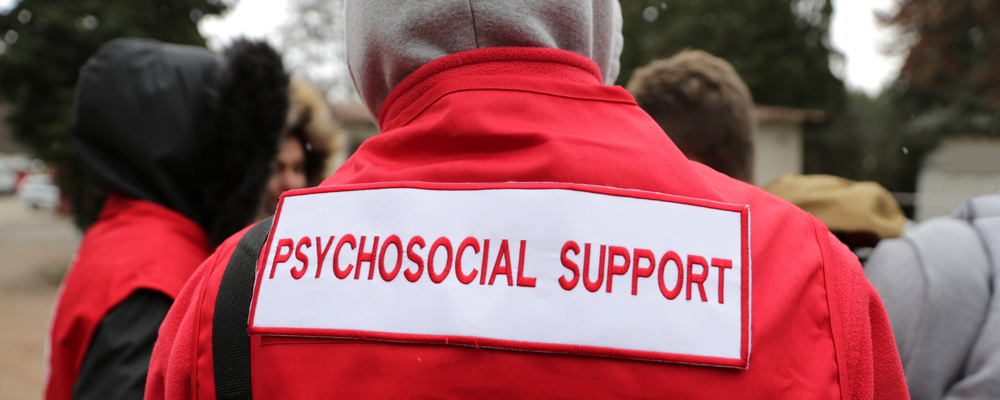 Image Source: Shutterstock Images
Image Source: Shutterstock Images
By Thanh Thuy Truong, Asim Shah, Wayne K. Goodman, Sophia Banu, Alison Salloum, Laurel Williams, and Eric A. Storch
Implications for Public Health
Mental health care in emergency shelters is critical to both short- and long-term emotional recovery. Planning for provision of mental health services should consider availability of medication, confidentiality, and outreach to ensure individuals are aware of resources.
Most of us trudge through our daily activities with a sense of familiarity and routine. We go to work or school, tend to our loved ones, and care for ourselves if time permits. Anticipation and preparation for a natural disaster might not be priority for most people, and even if it were, an event as destructive as Hurricane Harvey could render many plans ineffectual.
This was the case for some when Harvey submerged Houston, Texas, seemingly overnight on August 25, 2017. Nearly 800,000 Houstonians were evacuated as water poured into their homes and multi-story houses, cars, and treasured objects were completely underwater. Many lost loved ones, including pets, who were swept away by the rushing current. As houses disappeared and lives were uprooted in an instant, the city faced a humanitarian crisis that warranted the largest disaster response in the history of the state. Houston’s healthcare system was tasked with providing medical and mental health care to thousands of displaced residents in an emergency setting, which raised challenges such as having limited individual healthcare information, staff turnover, and low supplies of medication.
As part of that response, our team of psychiatrists and therapists from Baylor College of Medicine arrived at the George R. Brown Convention Center (GRBCC) to help deliver mental health care to those displaced, although information and supplies were limited. The experiences and information gathered can provide useful lessons in how to better prepare shelters to provide mental health services.
The GRBCC is a place where tourists and residents typically gather to enjoy entertainment. But for the thousands of weary people escaping the impacts of the hurricane, it became a haven where they could find dry clothes and space to rest. The GRBCC was one of 692 temporary shelters that were erected in less than a week, housing about 10,000 of the 42,000 displaced residents whose other options had been destroyed in the storm.
Mass shelter situations can be stressful for even the most stable individuals, but for those with serious psychiatric conditions such as depression, bipolar disorder, or schizophrenia , they can be especially trying. It is imperative that shelter staff be able to assess the immediate medical needs of evacuees . We found that in some cases, people arrived at the GRBCC shelter without access to their medications, which had been left behind during the emergency evacuation. Some experienced a worsening of symptoms such as anxiety, while others developed new symptoms from the trauma. Insomnia was pervasive, draining energy and interfering with the ability to think clearly. Initially, only two medications—generic versions of Prozac and Zoloft—were available at the rapidly established on-site pharmacy. Fortunately, a generous donation from a local pharmacy stocked most needed medications in just two days.
We found another challenge was recordkeeping. Keeping documentation consistent was problematic due to providers switching shifts and collaborating with other organizations such as the Federal Disaster Medical Assistance Team. Even with the best efforts, organizing notes and ensuring appropriate follow-up care after leaving the shelter was difficult.
Regardless of the extent to which mental health services are needed—or offered—our findings show the shelter atmosphere is not conducive to seeking treatment. The privacy needed to discuss the whirlwind of emotions that people are experiencing is often an unavailable luxury. Despite GRBCC boasting nearly two million square feet of space, the center seemed crowded with evacuees bustling about trying to gather essential items and plan their next steps. The shelter had a makeshift clinic, but it wasn’t located in a discreet spot, so many individuals did not feel comfortable seeking psychological support or returning after their initial meeting.
The mental health team made creative attempts at engaging evacuees with signs stating, “Need to talk?”. However, when in psychological and physical shock, words can escape us. Confronted with such a powerful force as a natural disaster, vulnerabilities are laid bare. People often need to feel safe before they can verbalize their internal experiences. The team was able to intuit the multifaceted and complex ways in which people were processing trauma and provided support by other means—including assisting with access to food, clothing vouchers, medical care, or simply being present. We learned that support for basic physical needs is enough for most.
Disaster relief involves a complex system of moving parts, and psychiatric services are an important element. The invisibility of psychological disruptions can shift mental health to the backseat during a disaster response. Yet mental health concerns increase dramatically after disasters for children and adults alike. When individuals who need mental health support arrive at evacuation centers and are faced with limited medication supplies, and in non-ideal settings (e.g., limited confidentiality), it can discourage them from seeking help. We learned that faster intervention could occur if evacuation centers kept an emergency supply of common medications.
Without proper follow-up, these individuals are likely to deteriorate and experience even greater barriers to treatment such as transportation and cost. Providing patients with a list of options for treatment, a small supply of medications, and an appointment if possible may increase rates of follow-up. Our work at the GRBCC highlights the necessity of integrating emergency psychiatric services into disaster relief efforts to enhance emotional recovery and reduce risk of long-term psychiatric problems.
Suggested Tools
Addressing the Needs of the Seriously Mentally Ill in Disaster
Center for the Study of Traumatic Stress
This fact sheet reports on the needs of people with serious mental illness (SMI) after disasters and how their needs differ from those of people without SMI. It also discusses the ways disasters disrupt mental health services and how to help those with SMI.
Initial Intake and Assessment Tool
American Red Cross and U.S. Department of Health and Human Services
A shelter intake form for quickly assessing an individual’s functional, health, and psychosocial needs.
For a list of all the tools included in this special collection, visit the Mass Sheltering Tool Index. A list of further readings are also available.





Thanh Truong is a senior psychiatry resident at the Menninger Department of Psychiatry and Behavioral Sciences at Baylor College of Medicine. She is also a fellow at the Center for Psychoanalytic Studies, where she is deepening her training in psychodynamic psychotherapy.